# EDDK - Köln/Bonn Airport
# EDDK - Overview
Köln/Bonn is a complex airport with crossing runways and very little space on the ground and in the TMA. On VATSIM, it usually has a medium amount of traffic but will regularly operate at or even above capacity during events.
**Köln/Bonn is an unrestricted airport.** DEL and GND are unrestricted and can be staffed by all controllers with an S1 rating or higher who have passed the **required moodle courses**. TWR position requires the EDDK\_TWR Tier 1 endorsement which can be acquired by all controllers with an **S2** rating or higher. All radar positions require the EDDK\_APP Tier 1 endorsement which can be acquired by all controllers with an **S3** rating or higher.
Due to the high amount of complexity of the airport, it is highly recommended that **S1-rated controllers** have gained a great deal of experience at other unrestricted airports before staffing positions at Köln/Bonn.
**Training:** Controllers with the S1 rating can staff TWR during their training (active EDDK\_TWR solo endorsement required). Controllers with the S2 rating can staff APP positions during their training (active EDDK\_APP solo endorsement required).
With AIRAC 2404, the runway designators in Köln/Bonn were changed from 14/32 to 13/31. This can cause issues for pilots using MSFS if they are using AIRAC 2404 or later but have a scenery with the old designators as **they will not be able to select certain runway-specific procedures such as the SID** in their FMS. If a pilot reports this issue, **please refer them to [this addon](https://dms.vatsim-germany.org/s/PXXa3gKYbb2Exkx "EDDK compatibility fix")** which will allow them to select runway-specific procedures even with an outdated scenery.
Whenever possible, **controllers should find workarounds that do not require pilots to restart their simulator**, e.g. using a conventional SID to NVO or WYP, potentially followed by radar vectors.
### Köln/Bonn ATC Stations
| **Station**
| **Station ID**
| **Login**
| **Frequency**
| **Remarks**
| **Endorsement**
|
| **ATIS**
| ADK
| EDDK\_ATIS
| 132.130
| --
| --
|
| **Delivery**
| DKC
| EDDK\_DEL
| 121.855
| --
| unrestricted: [EDDK CBT Delivery](https://moodle.vatsim-germany.org/course/view.php?id=79 "Course EDDK (VATGER moodle)")
|
| **Ground**
| DKG
| EDDK\_GND
| 121.730
| --
| unrestricted: [EDDK CBT Delivery & EDDK CBT Ground](https://moodle.vatsim-germany.org/course/view.php?id=79 "Course EDDK (VATGER moodle)")
|
| **Tower**
| DKT
| EDDK\_TWR
| 124.980
| --
| Tier 1: [EDDK\_TWR](https://core.vateud.net/my/endorsements "Your endorsements (VATEUD Core)")
|
| Approach
(Pickup)
| DKA
| EDDK\_APP
| 135.350
| --
| Tier 1: [EDDK\_APP](https://core.vateud.net/my/endorsements "Your endorsements (VATEUD Core)") |
| Arrival
(Feeder)
| DKAT
| EDDK\_F\_APP
| 121.055
| secondary
| Tier 1: [EDDK\_APP](https://core.vateud.net/my/endorsements "Your endorsements (VATEUD Core)") |
| **Nörvenich sector**
| NOR
| EDDK\_NOR\_APP
| 127.365
| primary | Tier 1: [EDDK\_APP](https://core.vateud.net/my/endorsements "Your endorsements (VATEUD Core)") |
### Controlzone
[](https://knowledgebase.vatsim-germany.org/uploads/images/gallery/2022-10/eddk-ctr.png)*Cologne-Bonn Controlzone (D-CTR) - © [openflightmaps.org](https://www.openflightmaps.org/)*
# EDDK - Delivery
VFR traffic, in contrast to real procedures, does not have to request startup at Delivery, but can report ready for taxi directly to the ground control.
**Startup:** When startup clearance cannot be given immediately or the pilot is not ready for startup within the next 5 minutes during high traffic situations, the pilot needs to stay on Delivery frequency until he receives startup clearance. If an expected startup time (TSAT) exists, the pilot should be informed about it. This procedure might be necessary during events with a lot of outbound traffic.
**Capacity:** Due to a limited capacity for outbound traffic on ground, there should not be more than **12** **active startup** clearances at the same time (including SUG, PBG, TXG).
**Euroscope:** Delivery shall ensure that the initial climb is set and the correct SID is coded into the flightplan (very important for Center!). When issuing startup the corresponding ground state "SUG" (Startup Given) and the clearance received flag need to be set.
### Departure Routes
The standard intrument departure procedures from Cologne-Bonn lead to the waypoints NVO, WYP, COL, PODIP and KUMIK. The initial climb for all departures is 5000 ft MSL. All SIDs except three non-RNAV departures have speed or altitude restrictions, the phrase "climb via SID" need to be used.
[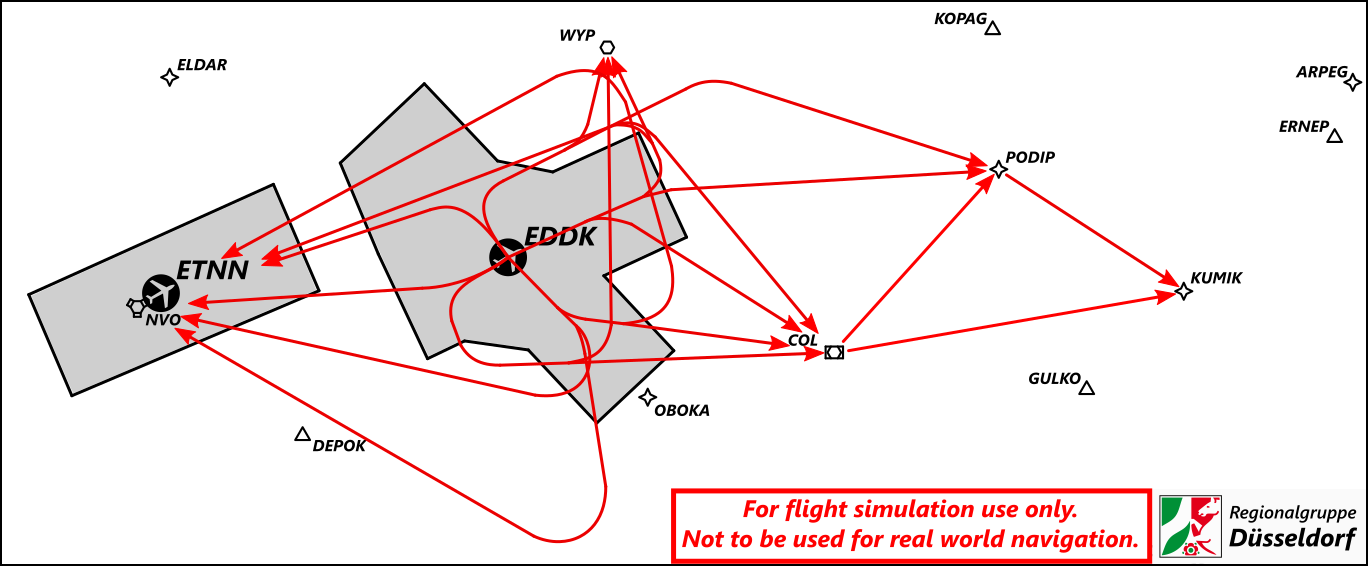](https://knowledgebase.vatsim-germany.org/uploads/images/gallery/2022-09/wLxgrafik.png)*Departure Routes out of Cologne-Bonn*
**General Restrictions:**
- The standard departure routes via **COL** are only used for local training flights or for flights to Frankfurt/Main EDDF.
**Runway 06, 24 and 31L:**
- Designators **K** (RWY 06), **D** (RWY 24) and **M** (RWY 31L) are the available RNAV departures.
**Runway 13L:**
- **Designator F** is prefered for all RNAV departures.
- **Designator Q** requires RNAV and RF-Legs capability and should be used only if filed by the pilot or on request.
- **Designator X** is only used for 3-engines heavies (e.g. MD11).
- **NVO#P** is used for departures unable to comply with the climb restriction on the F or Q SID.
- **NVO#W** by ATC only and requires prior coordination with Radar as the SID will cross the inbound stream. It is only used, if certain glider-areas are active (which are not simulated on VATSIM). **Appropriate flights must be announced to the approach controller by the tower before take-off.**
**Runway 13R:**
- **Designator E** is prefered for all RNAV departures.
- **NVO#C** is used for departures unable to comply with the climb restriction on the E SID.
- **NVO#V** by ATC only and requires prior coordination with Radar as the SID will cross the inbound stream. It is only used, if certain glider-areas are active (which are not simulated on VATSIM). **Appropriate flights must be announced to the approach controller by the tower before take-off.**
**Runway 31R:**
- **Designator B** is prefered for RNAV departures **above 98t MTOW** (e.g. B757).
- **Designator R** is used for all RNAV capable outbounds with **MTOW below 98t** as well as for A300 and A330.
- **NVO#R** requires RNAV and RF-Legs capability and should be used only if filed by the pilot or on request.
**Non-RNAV Departures** are only available via **NVO** and **WYP** out of runway 13L (**Y**), 31R (**N**), 06 (**U**) and 24 (**T**).
**RWY13R / RWY31L** departures can be assigned on a daily basis to small general aviation aircraft, as well as aircraft up to the category of A320/B738 if required. After coordination with Tower, RWY 13R can be used for all light and medium aircraft during high traffic situations.
With westerly winds, outbounds should be asked if they prefere **runway 24** (when active) or runway 13L/31R for departure.
### Quicksheet - Standard Instrument Departures
[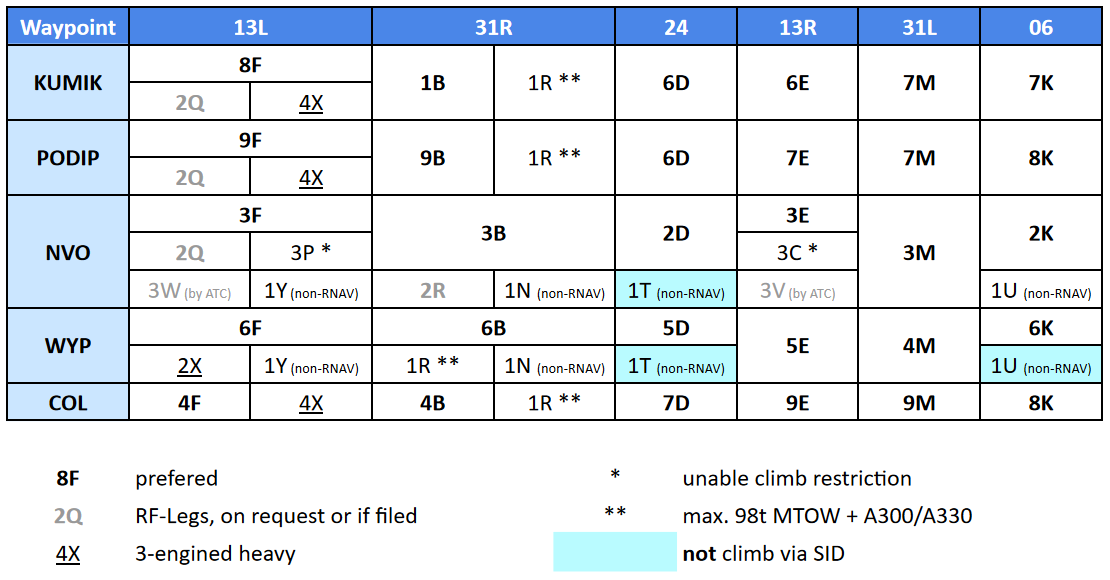](https://knowledgebase.vatsim-germany.org/uploads/images/gallery/2024-04/eddk-sids-2404.png)
### Vectored Departures
If pilots are unable to fly a standard instrument departure (even an older version of the current SID) a vectored departure can be coordinated between Delivery and Arrival.
Primary **runway heading** and an initial climb of **4000ft** should be used. Other coordinations are always possible. At Euroscope the SID with RVxxxxx should be selected (xxxxx = first waypoint).
### Datalink Clearance (PDC/DCL)
At Cologne-Bonn Airport we offer Datalink Clearance to the pilots throughout the **[Hoppie System](https://www.hoppie.nl/acars/)** and the Topsky Plugin. The airport code EDDK should be used (already preselected).
An example of the DCL message the pilot will receive can be seen below. Due to plugin limitations, the current default setting is "startup approved"; the **Startup option in the DCL window shall be set to "No" for every DCL** as pilots need to request startup separately on frequency.
Other DCL messages can be enabled within the Topsky CPDLC settings file manually.
CLD 1051 240418 EDDK PDC 012 EWG6TG CLRD TO LEPA OFF 13L VIA KUMIK2Q SQUAWK 1000 ADT MDI NEXT FREQ 121.855 ATIS R REPORT READY ON 121.855
### vSID Rules
The following alias commands (.command**<space><enter>**) can be used to toogle vSID rules.
| **Alias** | **vSID Command** | **Description** |
| **.high** | .vsid rule eddk high | all L/M outbounds will get runway 13R/31L for departure.
|
# EDDK - Ground
### Airport layout
Cologne-Bonn airport has three crossing runways.
[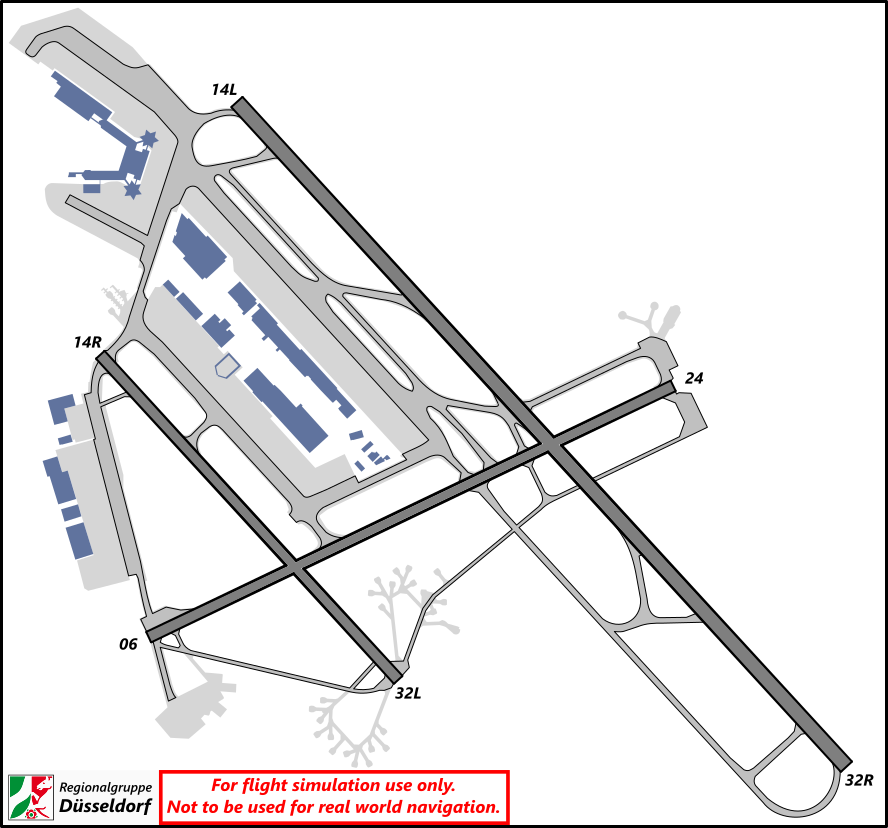](https://knowledgebase.vatsim-germany.org/uploads/images/gallery/2022-09/eddk-overview.png)*airport layout*
The airport has two passenger terminals. Terminal 1 with its two distinctive stars accommodates aprons A, B and C, and Terminal 2 with the apron area D.
[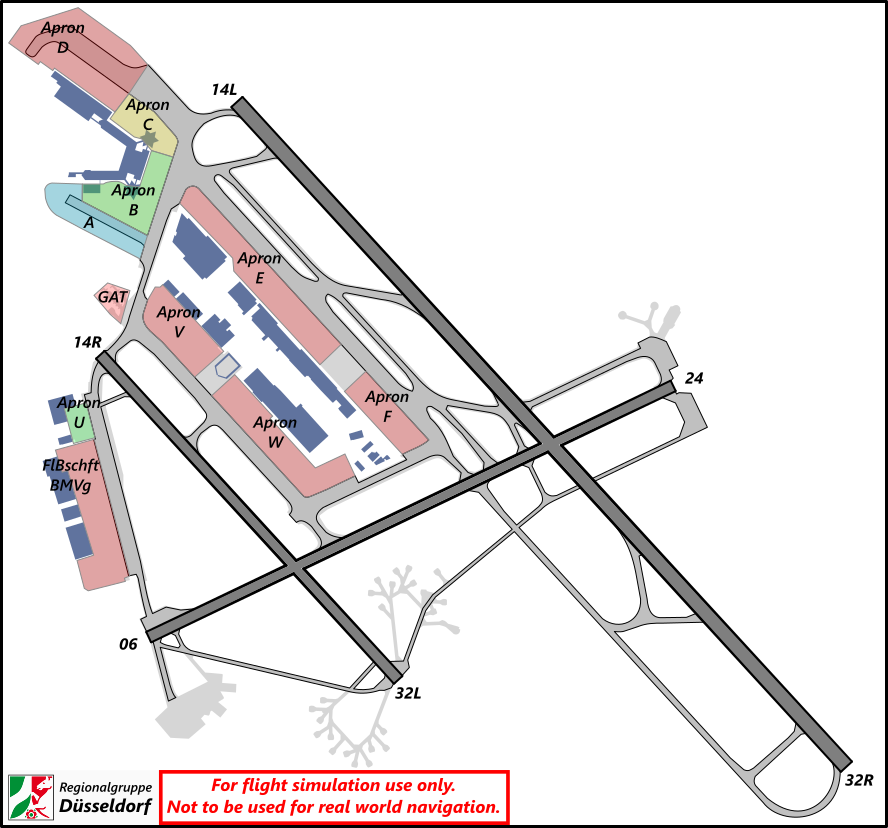](https://knowledgebase.vatsim-germany.org/uploads/images/gallery/2022-09/eddk-apr.png)*Apron areas*
The cargo area is used by several airlines and is located in the middle of the airport between the runways. It contains the apron areas E, F and W.
Apron V close to the cargo area is used for general aviation and business jets.
The military part of the airport is located west of runway 13R/31L at apron U. The military part of the apron is the home of the german Flugbereitschaft.
### Area of Responsiblility
The area of responsibility of Ground is located between the three runways and includes all aprons except the military apron U (see image below). If RWY 24/06 is closed (not in use), the runway crossing can be delegated to the Ground controller.
[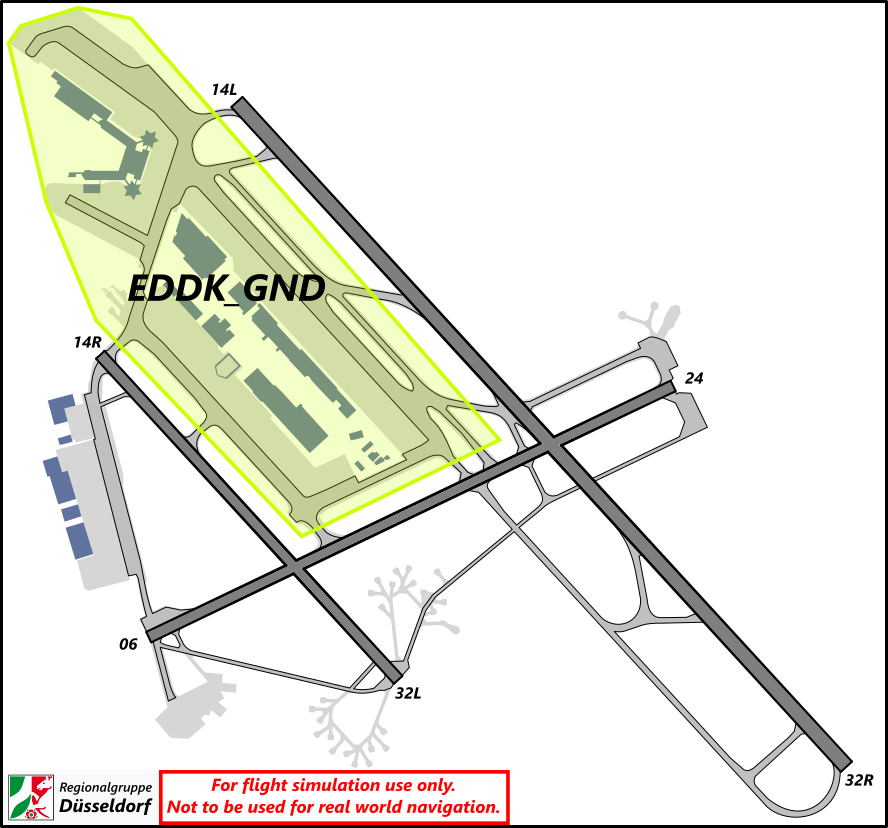](https://knowledgebase.vatsim-germany.org/uploads/images/gallery/2022-09/eddk-aor.png)Area of Responsibility - *Cologne-Bonn Ground*
**Runway Crossing:** The crossing of all runways is within the responsibility of Tower, but can be delegated to Ground if the appropriate runway is not in use.
### Parking Positions
Parking positions are assigned by the Ground Radar Plugin based on airline and aircrafttyp according real world usage. It is recommended to use the assigned stands. The maximum aircraft size for all parking positions can be displayed in Euroscope (Tower) with shortcut `ALT + B`.
**Aprons A - D:** These aprons are the passenger terminal aprons. Aprons A-C are used for Terminal 1, while Apron D is located at Terminal 2.
**Aprons E, F, V, W:** All of these aprons are home to the big cargo-city at Cologne airport. Most of the heavy lifting cargo fleet (e.g. B747), are parked on aprons E and F, while aprons Vand W are home to the small feeder fleet (e.g. B737, ATR and B757/B767).
**Apron U:** Apron U is used by two maintenance companies for customers' aircraft. Parking positions U10 - U14 can be used up to code C (A321/B739) and parking positions U16 - U26 only for code A (wingspan < 15m).
**Apron V:** Apron V is used for business jets and general aviation. Depending on the position, aircraft up to the size of a B737-BBJ can be parked.
**GAT:** The GAT has no real permanent home. Previously it was located as shown on the map below, northeast of the RWY14R threshold. Nowaday, general aviation is parking mostly on the aprons V and U (partially civil, partially military). The original GAT as shown on the map, is home to the helipad of the Christoph 3 rescue helicopter.
**Military:** Cologne/Bonn is a double purpose airport. While it mostly handles civilian aviation (either pax or cargo), it's also home to the Köln-Wahn Airbase, of the Luftwaffe. On the western part of the airport (west of 13R/31L), the so called "white fleet" (A350, 340, GLEX) is stationed. To complete the fleet stationed at EDDK, the MRTTs (Multi-Role-Tanker-Transport) A321 and A330 are also located there.
**Antonov AN225 special parking procedure:** Parking parallel to taxiway A on Stands E09 to E15, main gear on E12, facing north-west.
### Taxiway Usage
The primary used taxiway is A, running parallel to runway 13L/31R.
[](https://knowledgebase.vatsim-germany.org/uploads/images/gallery/2022-09/eddk-twy.png)Taxiways at *Cologne-Bonn*
**31-Operations:** During 31-Operations, traffic from the terminals taxiing southbound will be using TWY-A, while inbound traffic vacating the runway continues on TWY-E, to A5. If there is traffic requesting pushback on the E and F stands, outbound traffic can be rerouted via TWY-E. However, this may be blocking inbound aircraft vacating from RWY 31R.
**13-Operations:** During 13-operations, inbound traffic vacating RWY 13L, heading for the terminals, will be taxiing northbound on TWY-A primarily. However, if there is traffic on aprons E and F asking for pushback, the parallel TWY-E can be used as alternative, so that the traffic on those aprons is able to push.
**Runway 24/06 for taxi:** It is possible for in- and outbound traffic to use runway 06/24 for taxi.
> GAF1GH, taxi to holding point runway 31R via Bravo, enter runway 06 and Alpha, cross runway 31L.
> DAFHK, taxi right via runway 24 and continue T.
After landing or before takeoff, the word "backtrack" has to be used.
> EWG1PC, backtrack runway 24, vacate T.
> RYR7AF, backtrack and lineup runway 24.
### Taxiway Restrictions
Taxiway **B** and **T** can only be used up to **Code E** aircraft. Taxiway **C** is limited to **Code C** aircraft. Taxiway **D** between A and T can only be used by max. **Code E** aircraft. The part of **D** east of runway 13L/31R can also be used by a B748.
**Parallel taxi on A and E with Code F aircraft:** If an Airbus **A380** is on taxiway A, taxiway E is limited to **Code D** aircraft. If a **B748** or an **AN124** is on taxiway A, taxiway E is limited to **Code E** (in case of a B748 limited to Code E + B748).
**Colored lines:** In front of Terminal 2 aircraft up to code C can use the orange and blue line simultaneously up to position D51.
On taxiway **B** between L and T (marked with (!)) only aircraft with a **wingspan of max. 52 m** (Code D) and max. weight of 200t are allowed to taxi on it's own. Aircraft up to 234t may be towed over or taxi on their own power over the bridge **if guided by a marshaller.**
### Potential conflicts at the ground
Due to it's layout and placement of aprons, there are several critical areas at Cologne/Bonn Airport, which can either lead to congestion or taxi conflicts.
**1. The holdingpoint dilemma:**
The number one area marked on the map, is the area around the holdingpoint A5/A7, the northern ends of TWYs A and E, as well es TWYs B and M, around the C-Star (Terminal 1). Especially during 13-Ops, this area heavily suffers from congestion. Departing traffic will be queuing mostly at A7, some at A5, while inbound traffic will be taxiing northbound, via TWY A, B and M, to get to Apron D. Possibilities to solve at least some of the congestion issues, will be described on the following pages.
**2. A3-Area**:
Number two on the map, is the A3-Area. This areas is critical in different scenarios.
- During 31-Operations, A3 is the first suitable highspeed-turnoff for landing traffic. Due to the speed of landing and vacating aircraft, they often fail to stop short off E and continue through to A.
- Another critical situation occurs, in the case of 24-departures. 24-departures need to cross RWY 31R at A3. Whenever traffic is instructed to taxi in the direction of the A3 holdingpoint, Ground needs to coordinate with Tower and inform him about the traffic, as TWR needs to inform landing pilots, that A3 is unavailable to vacate the RWY.
**3. Taxiway B-Bridge**
The third critical area is placed on TWY-B. Between Taxilane-L and the GAT (marked with (!)) taxiway B leads over a bridge where only aircraft with a wingspan of max. 52 m (Codeletter D) and max. actual weight of 200 t are allowed to taxi on it's own. A332/A333 and A343 with an actual weight of up to 234 t may be towed or can taxi with a marshaller on ther own power over the bridge.
**4. Taxiway D**
On taxiway D only Code E aircraft and below are allowed, except the part east of runway 13L/31R where also a B748 is allowed.
[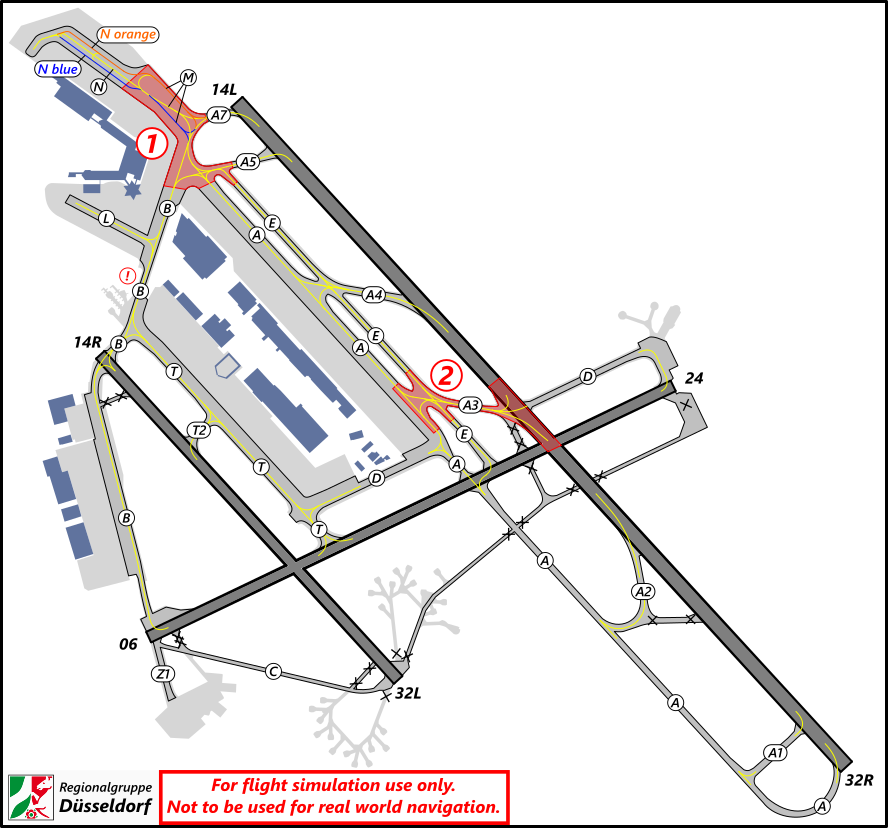](https://knowledgebase.vatsim-germany.org/uploads/images/gallery/2022-09/eddk-risk.png)*Potential conflicts on ground*
### De-Icing
There are no de-icing pads available at EDDK. Every outbound has to be deiced **on position prior pushback!** In case deicing is required when the outbound is already offblock, it has to return to a position.
# EDDK - Tower
### Runways
The airport has three runways, two of which run parallel and one of which crosses two runways.
#### Runway 13L / 31R
Runway 13L/31R is the longest runway at 3815 x 60m and is primary used for all inbound and outbound traffic. Runway 31R and 13L are both equiped with ILS CAT III.
#### Runway 13R / 31L
At a distance of about 1km southwest of runway 13L/31R is the much shorter parallel runway 13R/31L, which is 1863 x 45m long.
Due to its length and technical equipment, this runway is preferably used for VFR traffic. Because of its proximity to the military section, it is also frequently used by military aircraft. Runway 13R/31L is only approved for aircraft up to code C (e.g. B739, A321). During high traffic situations, this runway can be used for all light and medium traffic that is able (TORA 1863 m).
For **non-precision approaches** to runway 13R, a flight and ground visibility of at least 2.1 km must be provided due to the shortened approach lighting.
#### Runway 06 / 24
Across runways 13/31 is the intersecting runway 06/24, measuring 2459 x 45m. Only landing direction 24 is equipped with an ILS (CAT I). For RWY 06 only non-precision approaches are available.
Runway 06/24 is only approved for aircraft up to code letter E, including the B748.
For **non-precision approaches** to runway 24, a flight and ground visibility of at least 1.5 km must be provided due to the obstacle situation.
RWY24 can be used to taxi aircraft as well. Either because of wingspan limitations on TWY D or to the military apron, as well as for aircraft landing RWY13L to vacate the runway and to avoid the sharp turn into A3.
> DLH123, wind 140 degrees 4 knots, runway 13L cleared to land, runway 24 available for taxi.
### Control Zone
The D-CTR of Cologne-Bonn Airport extends from the ground to 2500ft MSL.
[](https://knowledgebase.vatsim-germany.org/uploads/images/gallery/2022-10/eddk-ctr.png)
*Controlzone Cologne-Bonn (D-CTR) - © [openflightmaps.org](https://www.openflightmaps.org/)*
**Airfields:** South of the control zone lies the airfield Bonn-Hangelar EDKB, which, including its traffic circuit, is located outside the control zone.
To the north, also outside the control zone, is Leverkusen EDKL airfield. Its traffic circuit, however, extends into the control zone at an altitude of 1100ft on its southern side.
Please note the following: "From SR-30 until SS+30, the control zone in the depicted Dünnwald sector is not active. The general airspace classifications G (up to 1000ft AGL) and E (above 1000ft AGL) apply." (Source: [*AIP VFR Germany VOC EDKL*](https://aip.dfs.de/BasicVFR/pages/P0034A.html))
**Hospitals:** Several hospitals with helipads are located in the urban area of Cologne.
In the extended centerline of runway 13L, approx. 1.5 km north of the NDB LJ, is the hospital Merheim. Approaches to runway 13L fly over the hospital at approx. 1500ft. Helicopters may approach the landing area below the approaching traffic. Appropriate traffic information must then be provided to avoid missed approaches.
On the north-western edge of the control zone in Cologne-Nippes, on the CTR boundary, is the rather seldom approached St. Vinzenz Hospital.
On the west side in the Lindenthal district, just outside the control zone, is the University Hospital of Cologne.
To the west of the control zone is the Nörvenich ETNN airbase. Despite their proximity, the control zones of the two airports do not border directly on each other, but are separated by a narrow strip of type C airspace.
### VFR-Traffic
There are 7 mandatory reporting points and 1 optional reporting point available for VFR traffic at Cologne.
| **Reporting Point**
| **Location**
|
| **NOVEMBER 1** | BAB 4, exit Bergisch Gladbach-Bensberg |
| **NOVEMBER 2** | BAB 3, motorway service station Königsforst-Ost |
| **ECHO 1** | Church in the middle of Neunkirchen |
| **ECHO 2**
*(Optional)*
| BAB 3, service area Sülztal |
| **SIERRA 1** | Marina at the mouth of the Sieg River into the Rhine |
| **SIERRA 2** | Sports facilities north of the village of Troisdorf-Spich |
| **KILO 1** | BAB 1 / BAB 57, motorway interchange Köln-Nord |
| **KILO 2** | BAB 4, rhine bridge Rodenkirchen |
**VFR Routings:** The most popular VFR route through the control zone follows the Rhine along the Cologne Cathedral and the Old Town and connects the mandatory reporting points S1, K2 and K1.
Just as popular for flights from / to the Bergisches Land are take-offs or landings in Bonn-Hangelar combined with a flight through the control zone via the S and N routes.
**VFR Squawk:** All VFR traffic inside the controlzone of Cologne will get the transpondercode **7003**.
**Helicopter traffic:** The airport has frequent helicopter traffic. On the one hand, this is due to the fact that a helicopter squadron of the Federal Police is located at Bonn-Hangelar Airport and training traffic also takes place there. On the other hand, two rescue helicopters are stationed at the airport. "Christoph 3" (CHX3) has its landing pad at the GAT, while the intensive care transport helicopter "Christoph Rheinland" (CHX75) of the ADAC has its base at the north-western edge of the V- Apron towards Taxiway B. Only "Christoph 3" though, is allowed to land and depart directly from it's helipad. Every other helicopter has to either land on the runway or the runway threshold (e.g. 13R) and has to air-taxi to it's final position afterwards.
### Direction of Operation
Up to a tailwind component of 5kt, operations will be handled via runways 31R and 31L. Runway 24 is also used if necessary up to a tailwind component of 5kt.
Operating direction 06 is used extremely rarely because the wind through the Cologne Bay preferably blows from a northerly to northwesterly direction.
In order to accelerate the taxiing of traffic and after prior coordination with ground control, the tower may give taxiing traffic (taxiways A3-A4) an initial taxi instruction into taxiway A or taxiway E (depending on the take-off direction) and then hand it over to ground control. Most commonly, tower will give an initial right turn on E, to hold short of A5.
### Parallel Operations
Due to the distance of only approx. 1150 m between the runway centrelines of 13L/31R and 13R/31L, independent parallel runway operations between these runways for IFR and/or SVFR traffic are not permitted.
Radar and runway seperation need to be applied, wake turbulence separation is not required.
### Seperation and Spacing:
Depending on the amount of departures, Köln Tower may request arrivals to runway 31/13 with 5 or 6 miles. Coordination is required if more spacing is needed.
Targetspacing for inbounds only need to be applied by Arrival when **requested by Tower!** Otherwise radar or WTC seperation is used by default.
Note: In order to maintain seperation Köln Tower may reduce aircraft after transfer of communication.
While not neccesary, it is recommended to only use speed control after prior coordination with the Arrival Controller.
#### Reduced runway separation
RRS minima may be applied by Köln/Bonn Tower, according to the following table:
| **Runway** | **preceding CAT 1/CAT 2**
**succeeding CAT 1**
| **preceding CAT 1/CAT 2**
**succeeding CAT 2**
| **preceding CAT 3**
**succeeding CAT 1/CAT 2/CAT 3**
|
| **13L/31R** | 600m | 1500m | 2400m |
| **13R/31L** | 600m | N/A | N/A |
| **06/24** | 600m | 1500m | N/A |
### RECAT-EU procedures
According to new wake turbulence minimum separation values established by Eurocontrol, the familiar categories established by the ICAO (Light, Medium, Heavy, Super) have been divided into new sub-categories, thus offering the possibility of separating aircraft in certain categories even more closely.
The DFS has decided to apply the procedure at Cologne Bonn, but only in the “Lower Heavy/Lower Heavy” category and restricted to aircraft types A300, B757 and B767.
This means that two consecutive aircraft **(WTC H)** can be seperated by 3 miles and do not have to be seperated by 4 miles, as required by ICAO guidelines, if the preceeding aircraft is one of the of the above-mentioned aircraft type. For further information: [RECAT-EU](https://www.eurocontrol.int/publication/european-wake-turbulence-categorisation-and-separation-minima-approach-and-departure)
### Missed Approaches
For all published approaches, missed approaches will be executed as published unless otherwise coordinated.
EDDK Tower has to ensure initial separation between departures and between departures and missed approaches. He therefore may take action to ensure or reestablish seperation. Radar shall be informed immediately of the action taken. Transfer of Communication then takes place, once seperation is established. Missed Approaches should be tranfered to Feeder (DKAT), if not otherwhise coordinated. The next departure requires a departure release.
### Crossing Runway Operations
Combined operation of runways 13L/31R and 24 has the highest capacity. When runway 13R/31L is used as well, runway 24 is blocked for significantly longer.
It is important during crossing runway operations that the preceeding traffic (landing or departing) has crossed the runway cross before the succeeding traffic (landing) for the other runway has reached the 1 NM final. Otherwise the succeeding traffic has to go around.
**Example:** Departing traffic runway 31R has passed the runway cross before the inbound reaches 1 NM final for runway 24.
### Nörvenich sector A
If the military approach sector for Nörvenich (ETNN) has activated sector A, **NVO SID´s out of runways 24 and 31, as well as COL departures out of runway 24 may no longer depart. Coordination with DKA required.**
Usually, this sector will only be active for short periods of time to allow TNNA to vector arriving traffic to final approach during 24 operations at ETNN; however, when there is local IFR traffic at ETNN, the sector may be activated for longer periods.
After coordination with DKA NVO outbounds should be recleared to runway 13 or, on a different SID (e.g. COL/WYP) to expect vectors to NVO after departure.
**DKA** (or TNNA, if DKA is offline) **will inform Tower when sector A is activated and deactivated**.
### Transfer of Communication "Auto Handoff":
Köln/Bonn utilizes an auto-handoff procedure for IFR departures where **Tower will not hand off outbounds to the arrival controller**. Make sure to set the correct departure frequency in the ATIS.
Outbounds should contact APP **when passing 2.000 ft MSL** unless explicitly told to remain on Tower frequency.
# EDDK - Arrival
The area around Cologne is divided into four sub-sectors. In addition to the Approach and Arrival stations, sector NOR handles the lower airspace west and above Cologne up to Maastricht/Rhein Radar.
NOR is the primary station and covers all other Sectors top-down. If only DKA is staffed, this sector will not cover NOR.
DKA frequency shall always be cross-coupled by the responsible controller.
Please also **check the [ETNN TWR/APP](https://knowledgebase.vatsim-germany.org/books/sops-fir-langen/chapter/etnn-norvenich-airbase) and [EDDK Tower, Ground, and Delivery](https://knowledgebase.vatsim-germany.org/books/sops-fir-langen/chapter/eddk-kolnbonn-airport) SOPs** to familiarize yourself with relevant procedures for Arrival operations and to enable the necessary coordination with the ground stations.
## Sectorization and Airspace
### Cologne Approach (DKA)
Approach is responsible for the area around Cologne/Bonn Airport up to the Belgian border. The sector handles all departures from Cologne and presequences all inbound flights for the feeder. If arrivals or departures from Nörvenich (ETNN) take place without Nörvenich Radar (TNNA) being staffed, this traffic is also handled by Approach.
| [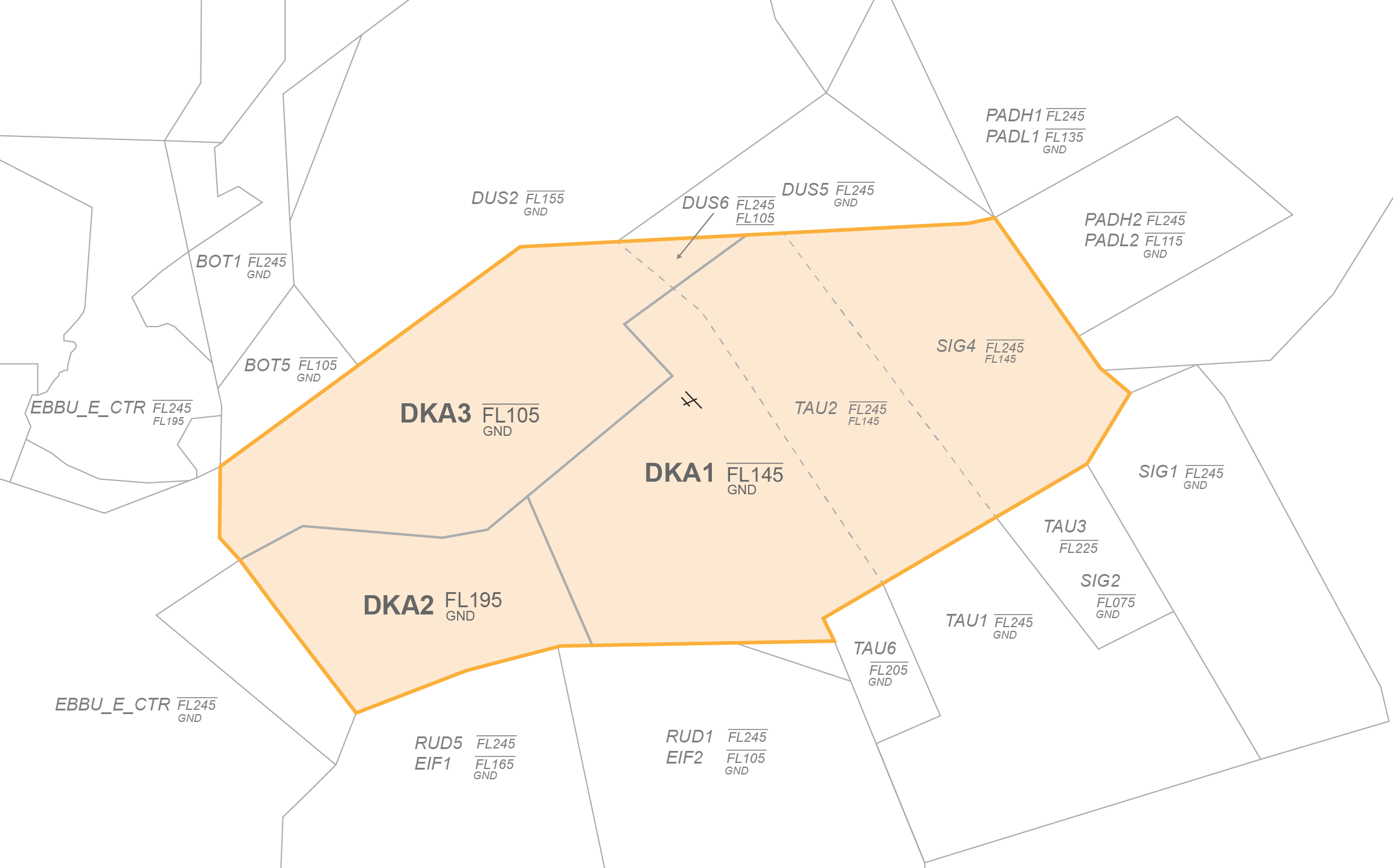](https://knowledgebase.vatsim-germany.org/uploads/images/gallery/2025-01/ozxdka-sector-at-2x-cropped.png) |
| *Area of Responsibility Arrival*
|
### Langen Radar Sector Nörvenich (NOR)
Langen Sector Nörvenich NOR is located west of the airport above sector DKA and is primarily responsible for the pre-sequencing of inbound flights to Düsseldorf from IBESA via ELDAR and BIKMU. In addition, the sector is responsible for all departures from Cologne to Belgium via NVO.
Frankfurt Outbounds via DITAM - OBOKA also pass through the sector, as do inbound flights to Brussels ACC via UMUPU - GEBSO and NEREL - AGENI.
| [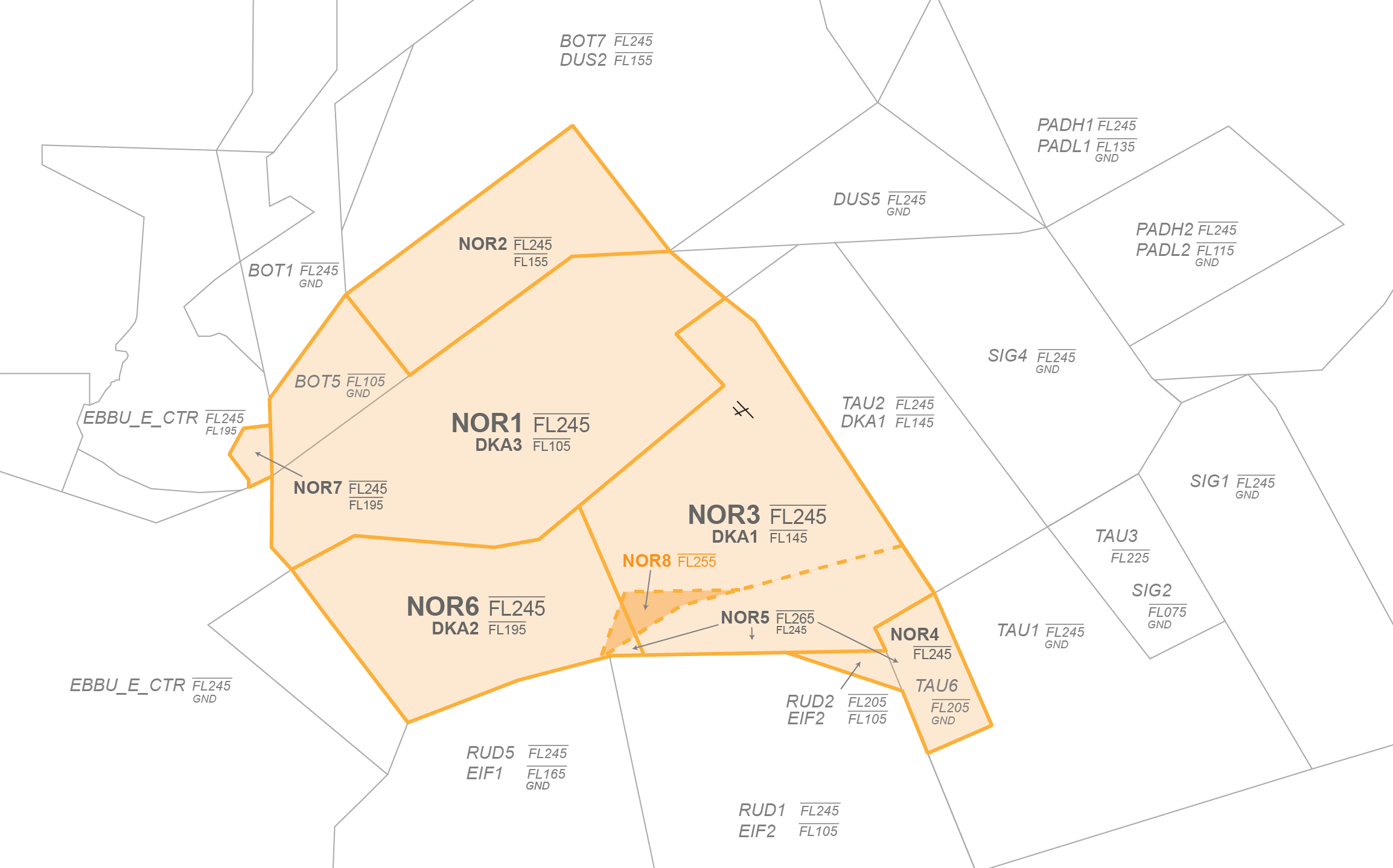](https://knowledgebase.vatsim-germany.org/uploads/images/gallery/2025-01/jZhnor-at-2x-cropped.png) |
| *Area of Responsibility Sector Nörvenich*
|
##### UMUPU & DEVRU Area and Upper Sector Boarders:
The red area shown below reaches up to FL265 and is delegated airspace of EDUU sector Nattenheim. It therefore boarders to MUAC Sectors Ruhr & Olno. The orange part reaches up to FL255 and is delegated by EDYY Olno.
Minimum Radar Seperation above FL245 is increased to 5 NM, which also applies to flights within this area. It is mainly used for Frankfurt outbounds via DITAM-OBOKA and flights to Brussels Group via UMUPU - GEBSO.
[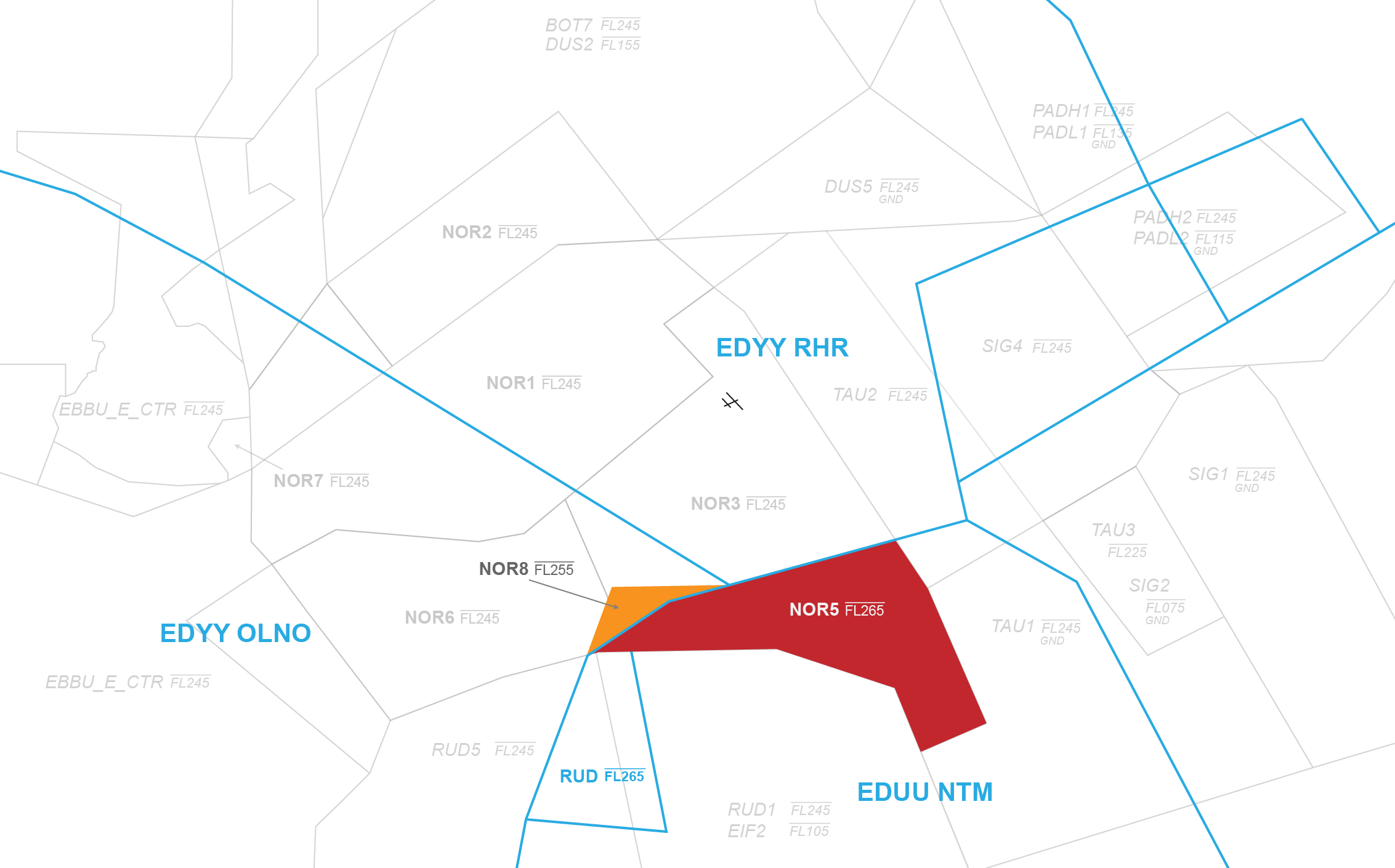](https://knowledgebase.vatsim-germany.org/uploads/images/gallery/2025-01/dka-umupu-area-at-2x-cropped.png)
###
Feeder/Arrival (DKAT)
The Feeder (Arrival) works within the sector of Approach (DKA). Especially during 13 operations the small area between FAF and the Düsseldorf Arrival sector border might require closer coordination between DKA and DKAT. The Feeder has no delegated AoR but instead operates within the same Airspace as DKA. There are no specific transfer conditions. Usually, traffic is handed off descending to FL70. DKA has the discretion to hand off traffic at any level, as long as seperation is ensured.
### Nörvenich Radar (military position)
For arrivals to, departures from, and local traffic at the military airbase Nörvenich (ETNN), the station Nörvenich Radar (TNNA) can be staffed. This position is delegated part of the DKA airspace when it is online. Due to the close proximity to EDDK and EDDL, **coordination between all positions is essential**.
The most eastern part of the Nörvenich approach sector, **sector A, is generally not delegated to TNNA** and can be used by DKA. However, **while there is inbound traffic for ETNN's runway 24, TNNA can activate this part of the sector** to be able to guide traffic onto the final approach course. Nörvenich Radar shall inform DKA immediately when activating and deactivating sector A and shall make sure to open the sector only for the absolute minimum amount of time required.
While sector A is active, **approaches to runway 06 in EDDK need to be coordinated** (airspace crossing with ETNN). Both final approaches courses are procedual seperated by more than 3 NM.
**Approaches to RWY 24** in EDDK are generally possible. In case of missed approach, immediate coordination between DKA and TNNA is required. It may therefore be beneficial to point out traffic approaching runway 24 in advance to TNNA.
Additionally, **NVO departures out of runways 24 and 31, as well as COL departures out of runway 24** are suspended/need to be coordinated in form of airspace crossing with TNNA.
**DKA shall immediately inform Tower when sector A is activated and deactivated**.
Nörvenich Radar may use the entire lateral range of the sector. Langen Radar (DKA) is responsible for maintaining full radar separation to the TNNA sector borders.
> **TNNA**: DKA, Nörvenich Radar.
> **DKA**: Go ahead.
> **TNNA**: Sector A now active.
> **DKA**: Roger.
>
> **DKA**: Tower, DKA.
> **DKT**: Go ahead.
> **DKA**: Nörvenich sector A active, hold all 24 & 31 NVO departures and 24 COL departures.
> **DKT**: Roger, holding 24 and 31 NVO departures and 24 COL departures.
[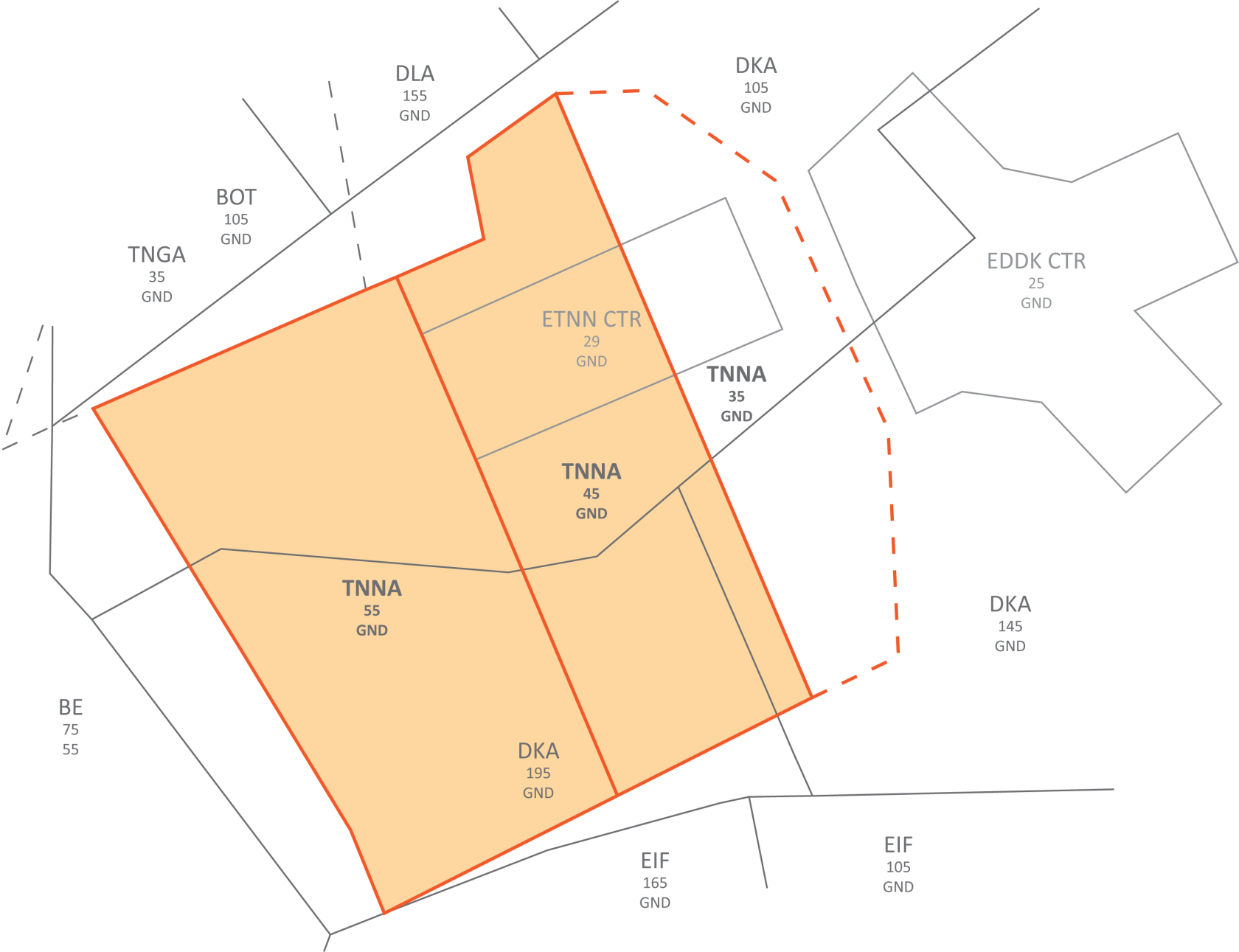](https://knowledgebase.vatsim-germany.org/uploads/images/gallery/2024-04/etnn.png)
*delegated sector to Nörvenich Radar (TNNA)*
Additionally, a small section of the **military position Frisbee Radar (TNGA) protrudes into DKA** airspace in the Northwest if it is active.
### Airspace Structure
One of the most complex airspace structures in Germany is located around Cologne and Düsseldorf airports, because several airports are located next to each other in a very small area.
Around Cologne there is pirmarily airspace C. Due to the close proximity to the Düsseldorf TMA, the airspace C in Cologne is directly connected to the airspace C in Düsseldorf.
A more detailed representation of Airspace C borders can be found at [openflightmaps](https://www.openflightmaps.org/ed-germany/).
[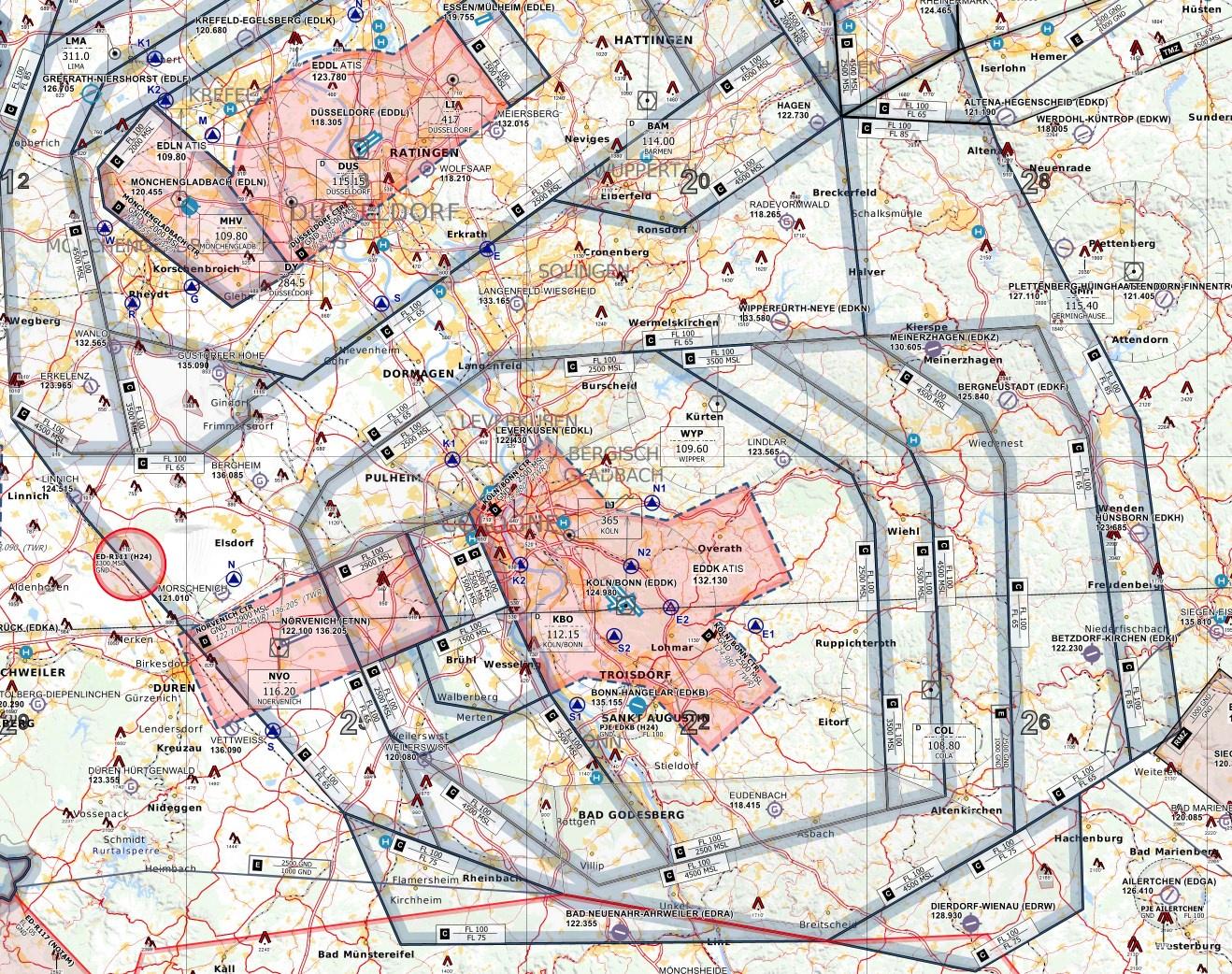](https://knowledgebase.vatsim-germany.org/uploads/images/gallery/2025-01/airspace-structure-eddk.jpeg)*Airspace EDDK - © [openflightmaps.org](https://www.openflightmaps.org/)*
### Minimum Vectoring Altitude (MVA)
| [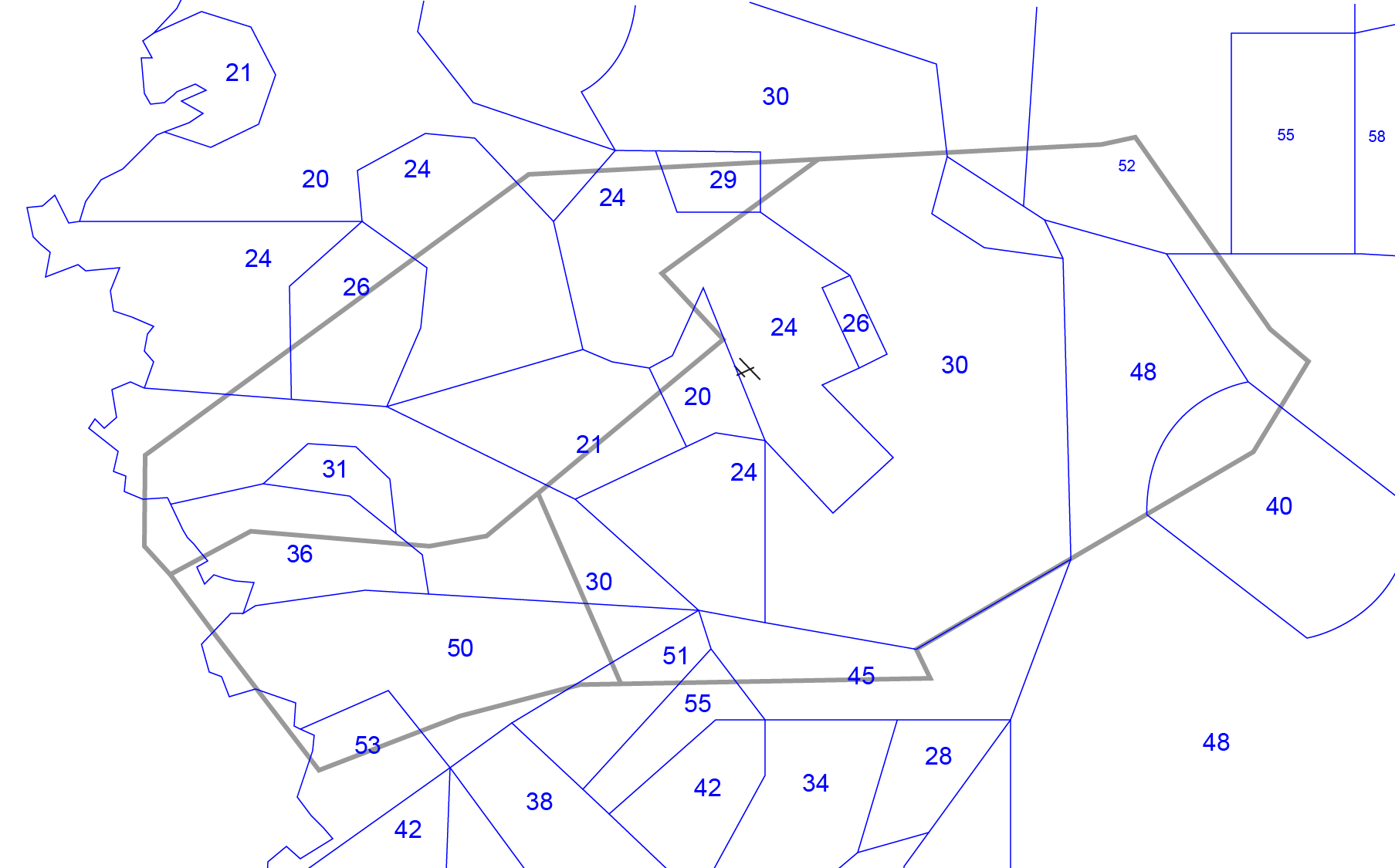](https://knowledgebase.vatsim-germany.org/uploads/images/gallery/2025-01/eddk-app-winter-mva.png)
| [](https://knowledgebase.vatsim-germany.org/uploads/images/gallery/2025-01/eddk-app-summer-mva.png)
|
| *EDDK Winter MVA*
| *EDDK Summer MVA*
|
###
For Approaches to runways 31 and 24, the MVA is exactly at the intercept altitude for the published instrument Approaches.
In case of an overshoot, the controller must pay special attention to the MVA.
### Range/Noise-Abatement Rings
When selecting the active runways in the EDDK\_APP sector file, green rings will appear around the intermediate Fixes DK455 (13), DK654 (31), DK554 (24) and DK755 (06), respectively for the selected runways.
They show a 13 NM radius to the specified waypoint. In real-life, they are primarily used for noise-abatement reasons, as between 22:00 lcl time and 8:00 lcl, traffic may only descend below FL70 within these circles. For aircraft types B747 and MD11, this restriction applies throughout the day.
For Vatsim, they are especially useful to create a proper inbound sequence and calculate remaining track miles to intercept/touchdown. Any traffic on the border of a circle will have exactly 26 NM to touchdown, if taken straight-in. Therefore, if two aircraft from opposite direction reach the circle at the same time, one will have to be delayed. This significally simplifies estimating sufficient delay for inbounds from opposite directions, especially for presesequencing inbounds to the crossing runway system and within the small area between Final Approach Point for runway 13/31 and the DUS/TAU sector border.
*[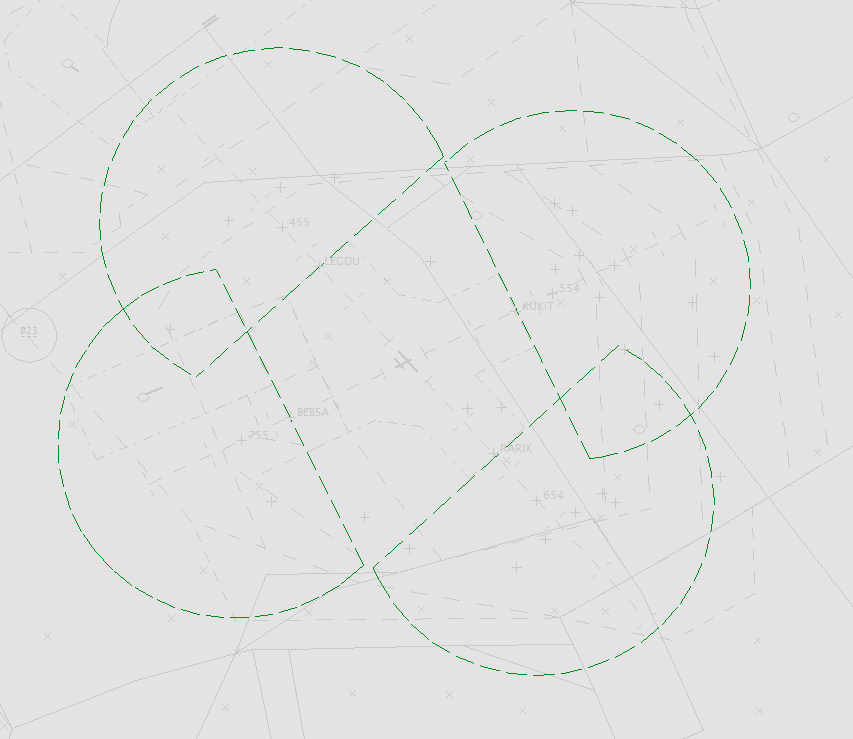](https://knowledgebase.vatsim-germany.org/uploads/images/gallery/2024-12/eddk-grune-kreise.png) Noise-Abatement Rings for all runways*
## Arrival and Approach Procedures
**Arrival Routes:** The standard arrival routes for Cologne-Bonn start at five waypoints: KOPAG, ERNEP, GULKO in the east and DEPOK in the west and lead to the Initial Approach Fixes WYP and COL.
*[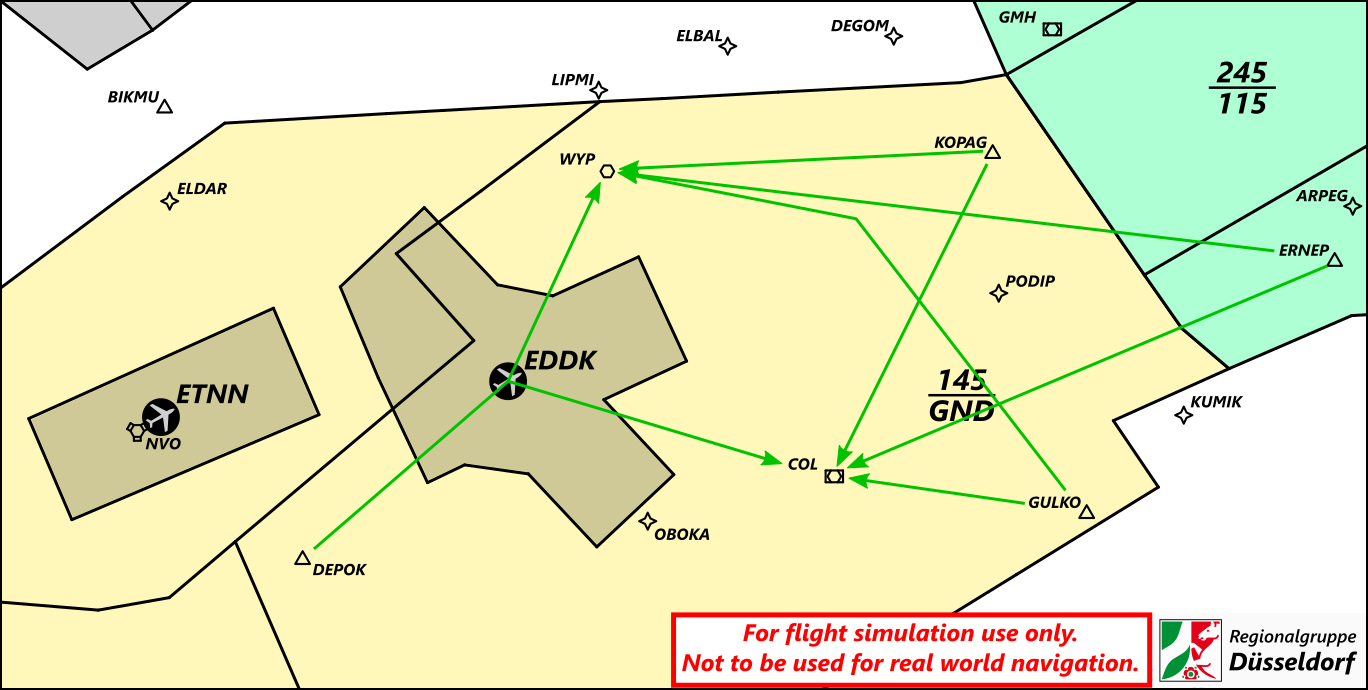](https://knowledgebase.vatsim-germany.org/uploads/images/gallery/2022-09/eddk-kopag.png)STARs into Cologne/Bonn*
### Clearance Limits
For all arriving aircraft via KOPAG and GULKO, those Points are also the clearance limit. Special attention must be paid to give a further lateral clearance in time, before the aircraft approaches the waypoint.
For aircrafts arriving via DEPOK or ERNEP the STAR point itself does not have a clearance limit and can be therefore followed until reaching the Initial Approach Fixes WYP (13) and COL (31). Those IAF are already located close to the final approach sector (on downwind), so normally radar vectoring is used for all inbounds.
**Transitions:** RNAV transitions to the final approach are published for all runways. Their use depends on the current traffic situation and should be flexible accordingly. These Transitions only exists out of GULKO, KOPAG & NVO and are designed for Continous Descend Operations (CDA).
The transitions to runway 13 enter the 1.5 NM boundry to DLA. Therefore, these transitions can only be user after prior coordination with the respective controller covering DLA.
Since they are more or less leading straight in, they are not really designed to sequence a bigger amount of inbounds. **Instead radar vectoring should be used.**
**S-Transitions:** An exception are the transitions with Designator S to Runway 13L. These extend deep into the approach airspace of Dusseldorf . On VATSIM, these transitions should only be used in close coordination with the controller responsible for Düsseldorf in order to avoid conflicts with approaches and departures from Düsseldorf. Airspace crossing needs to be coordinated individually.
**N-Transitions:** The transitions with Designator N to runway 31R reaches with the base part into the sector Taunus TAU, which on Vatsim is usually served by Langen sectors Kitzingen (KTG), Gießen (GIN) or Rüdesheim (RUD). Its use has to be coordinated with the controller responsible for TAU/SIG.
**Approaches:** Besides the Surveillance Radar Approach (SRA), which is available for all runways, the following Instrument approach are available and can be used upon pilots request:
- RWY 13R/31L/06: only RNP
- RWY 13L/31R: ILS (CAT III) and RNP
- RWY 24: ILS (CAT I) and RNP
The SRA Approach should only be used during low traffic periods and when feeder (DKAT) is staffed. Only one aircraft should be on Feeder frequency, when commencing SRA approaches. For further information: [Surveillance Radar Approach](https://knowledgebase.vatsim-germany.org/books/military-procedures-4ok/page/military-radar#bkmrk-surveillance-radar-a)
### Potential Conflicts
Due to its size and the close proximity of approach and departure routes, the Cologne Arrival sector in the east of Cologne/Bonn has the greatest potential for conflict. Especially between the points KOPAG and COL near PODIP, several routes cross, so that special attention must be paid to (vertical) separation there.
[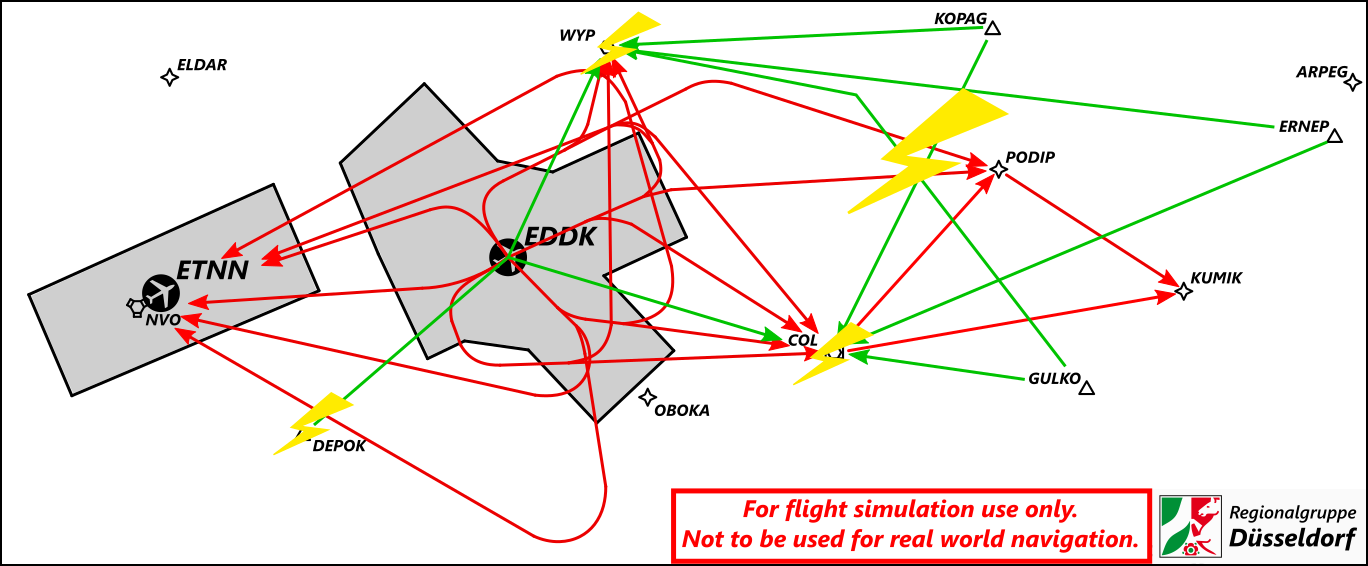](https://knowledgebase.vatsim-germany.org/uploads/images/gallery/2022-09/eddk-sidstarconflict.png)
### Arriving Traffic
#### Seperation and Spacing
Depending on the amount of departures, Köln Tower may request arrivals to runway 31/13 with 5 or 6 miles. Coordination is required if these can temporarily not be met or if Tower requires more spacing.
Targetspacing for inbounds only need to be applied by Arrival when **requested by Tower!** Otherwise radar or WTC seperation is used by default.
Note: In order to maintain seperation Köln Tower may reduce aircraft after transfer of communication without any prior notification.
#### RECAT-EU Procedures
According to new wake turbulence minimum separation values established by Eurocontrol, the familiar categories established by the ICAO (Light, Medium, Heavy, Super) have been divided into new sub-categories, thus offering the possibility of separating aircraft in certain categories even more closely.
The DFS has decided to apply the procedure at Cologne Bonn, but only in the “Lower Heavy/Lower Heavy” category and restricted to aircraft types A300, B757 and B767.
This means that two consecutive aircraft **(WTC H)** can be seperated by 3 miles and do not have to be seperated by 4 miles, as required by ICAO guidelines, if the preceeding aircraft is one of the of the above-mentioned aircraft type. For further information: [RECAT-EU](https://www.eurocontrol.int/publication/european-wake-turbulence-categorisation-and-separation-minima-approach-and-departure)
This Procedure is limited to the lateral and vertical sector limits of DKA and only applicable at or below FL100.
#### Missed Approaches
For all published approaches, missed approaches will be executed as published, unless otherwise coordinated. Tower has to ensure initial separation between departures and between departures and missed approaches. He therefore may take action to ensure or reestablish seperation. Radar shall be informed immediately of the action taken. Transfer of Communication then takes place, once seperation is established. Missed Approaches should be tranfered to Feeder (DKAT), if not otherwhise coordinated. The next departure requires a departure release.
#### High Rate of Inbound Traffic
**DLA Agreement:** During high traffic situations at EDDK with 13 operations and low traffic at EDDL, DKA can request a general airspace crossing to vector inbounds 13L/R through the DLA sector. Traffic need to stay at 5.000ft or below within AoR of DLA and at least 3 NM south of the extended centerline RWY 05R. Further individual coordination for level and extension possible when required.
The use of this crossing may be withdrawn, depending on the amount of departing southbound traffic in EDDL. Prior notification should be given around 10-15 minutes before withdrawal by DLA.
**TAU/EIF Agreement:** To use the sectors of EIF or TAU individual coordination required.
### Crossing Runway Operations
It is important during crossing runway operations that the preceeding traffic (landing or departing) has crossed the runway cross before the succeeding traffic (landing) for the other runway has reached the 1 NM final. Otherwise the succeeding traffic has to go around.
Arrival/Feeder has to ensure, that traffic cleared on the approach of crossing runways is separated in a way, that the preceeding traffic has passed the runway crossing point, before the succeeding traffic reached it's 1 NM final. Therefore it is necessary, that both aircraft are cleared on the approach, with at least 2 NM separation between each other. Especially factors like headwind and aircraft performance has to be taken into account.
**Runway 13L/31R + Runway 24 Operations:** Due to the shorter distance from the **FAF** (Final Approach Fix) to the crossing point between RWY13L/31R and RWY 06/24, arrivals on **RWY 24** shall be cleared as the preceeding aircraft whenever possible.
# EDDK - High Traffic Procedures
### Runway allocation
**Outbound 13 operation:** All outbounds with WTC Light and Medium are assigned runway 13R for departure. The 1863 m runway should be sufficient for most outbounds. If the pilot reports unable, he will be assigned runway 13L like all Heavies.
ATIS Code "**&eddk13r**" shall be used:
ALL DEPARTING LIGHT AND MEDIUM TRAFFIC EXPECT RWY 13R FOR DEPARTURE. REPORT UNABLE ON INITIAL CONTACT.
**Inbounds 13 operation:** Primary use of runway 13L for all inbounds, runway 24 should not be used.
**Outbound 31 operation:** All outbounds are assigned runway 31R.
**Inbounds 31 operation:** All inbounds with WTC Light and Medium are assigned runway 24. Inbounds Code D (B767/A306) should be asked if possible whether they can accept runway 24. All others will be given runway 31R.
**Start-up:** A maximum of two or three Heavies should be started up at the same time for 13L.
### Seperation and Spacing
Target spacing on runway 24 is 4 NM or WTC staggering if necessary (note staggering to inbounds runway 31R!).
Target spacing for runway 13L/31R of 6 NM by touchdown must be explicitly requested by the tower.
### Holdings
Primarily, only the holdings at **GULKO** and **KOPAG** in the centre's area of responsibility should be used. The holding via NVO should not be used due to the outbounds via NVO, **ERUKI** holding should be used instead.
Which holding is used for inbounds via ERNEP (GULKO or KOPAG) must be coordinated individually depending on the traffic situation (incl. transfer level).
To relieve DKA, PADH and GIN, the TAU/SIG sector combination can be used to manage the holdings. For KOPAG holdings above FL140, the transfer from PADH to SIG takes place at individually coordinated levels.
If holds in the APP area are required at short notice, only WYP (13L) and COL (31R, 24) are to be used, as otherwise there will be conflicts with outbounds. If only inbounds need to be delayed on the 31R, the COL holding in the APP area should be used for this.
Every 3 minutes (or every 6 minutes per ‘holding waypoint’), one aircraft from the KOPAG, GULKO or ERUKI holding can leave the holding (one orbit takes about 4 minutes). It should be noted that NVO/DEPOK inbounds are not prioritised and the delay is evenly distributed. Depending on the situation on the ground, the worst inbound rate is 12 inbounds per 30 minutes!
The inbounds are sent from the centre to WYP (13) or COL (31 and 24) at the normal transfer level to clear the holding. Individual arrangements are possible at any time.
**Inbounds 0 - 11:** no holds expected
**Inbounds 12 - 17:** consider outbounds, from 12 outbounds in 30 minutes, holds not excluded
**Inbounds 18 - 24:** take outbounds into account, from 6 outbounds in 30 minutes, holds likely
**Inbounds more than 24:** Inbounds exceed the maximum capacity even without outbounds, holdings unavoidable.